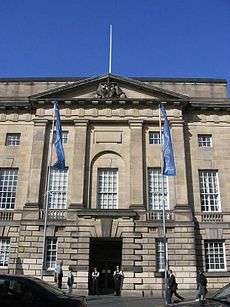HM Advocate v Coulson
| HM Advocate v Coulson | |
|---|---|
.svg.png) | |
| Court | High Court of Justiciary |
| Full case name | Her Majesty's Advocate v Andrew Coulson |
| Case history | |
| Related action(s) | HM Advocate v Sheridan and Sheridan |
| Court membership | |
| Judge(s) sitting | David Burns, Lord Burns |
Her Majesty's Advocate v Andrew Coulson was the trial of Andy Coulson, a former editor of the News of the World and former Director of Communications for David Cameron, on charges of perjury.
He was detained by Strathclyde Police on 30 May 2012 in London, and taken to Helen Street police station in Glasgow.[1] He was later charged with having committed perjury in 2010 during HM Advocate v Sheridan and Sheridan[2][3][4]

He appeared at Glasgow Sheriff Court on 13 June 2013 in private, represented by Richard Keen QC; no plea or declaration was made and he was given bail. There was a ban on reporting this at the time, but it was challenged by some media outlets and lifted a few days later.[5][6]
On 6 August a preliminary hearing took place at Glasgow High Court, he was not present, but the indictment was made public. [7][8]
The trial was scheduled to begin on 21 April 2015, and to last 6 weeks.[9][10] It was postponed because of the general election, and eventually started on 15 May 2015 at the Edinburgh High Court, with a jury of nine men and six women, presided over by judge David Burns, Lord Burns, Coulson was represented by Murdo MacLeod QC.[11][12]
On 1 June 2015, the judge acquitted Coulson. However, the acquittal was suspended while the Crown considered whether to appeal the decision and was therefore not announced until 3 June. Explaining his ruling, Lord Burns said that for Coulson to be found guilty it was necessary for the Crown to prove that the allegedly untrue evidence he had given at the 2010 Sheridan trial had been relevant to the issues in it. The judge added that it was for him, and not the jury, to decide on this aspect of the case and that the Crown’s legal submissions had failed to satisfy him that Coulson’s evidence had been sufficiently relevant to the Sheridan trial.[13][14]
See also
- Lallands Peat Worrier on the case (with links to judge's statements)
References
- ↑ "Andy Coulson charged in Tommy Sheridan trial perjury inquiry". BBC News. 30 May 2012. Retrieved 15 July 2013.
- ↑ Rose, Gareth (31 May 2012). "Scottish police charge Andy Coulson with Tommy Sheridan trial perjury". scotsman.com. Retrieved 31 May 2012.
- ↑ Carrell, Severin; Wintour, Patrick (30 May 2012). "Andy Coulson charged with perjury". The Guardian. London. Retrieved 31 May 2012.
- ↑ "Coulson charged over Sheridan trial evidence" The Herald (Glasgow), 31 May 2012
- ↑ "Andy Coulson appears in court on perjury charge", BBC News (Glasgow and West Scotland), 18 June 2013
- ↑ "Andy Coulson appears in court on perjury charge", The Herald (Glasgow), 18 June 2013
- ↑ http://www.heraldscotland.com/news/home-news/coulson-perjury-case-back-in-court.1407316018 Glasgow Herald August 2014
- ↑ http://www.bbc.co.uk/news/uk-scotland-28676197 BBC Scotland 6 August 2014
- ↑ "Andy Coulson faces perjury trial". BBC News. 23 February 2015. Retrieved 23 February 2015.
- ↑ http://www.theguardian.com/uk-news/2015/feb/23/andy-coulson-perjury-trial-date-set
- ↑ "Andy Coulson perjury trial begins in Edinburgh". BBC News. 15 May 2015.
- ↑ http://www.theguardian.com/uk-news/2015/may/19/andy-coulson-perjury-jury-hears-tommy-sheridan-trial-evidence
- ↑ "Andy Coulson cleared of perjury as trial collapses". BBC News Online. 3 June 2015. Retrieved 3 June 2015.
- ↑ HM Advocate v Coulson [2015] ScotHC HCJAC_49 (03 June 2015)